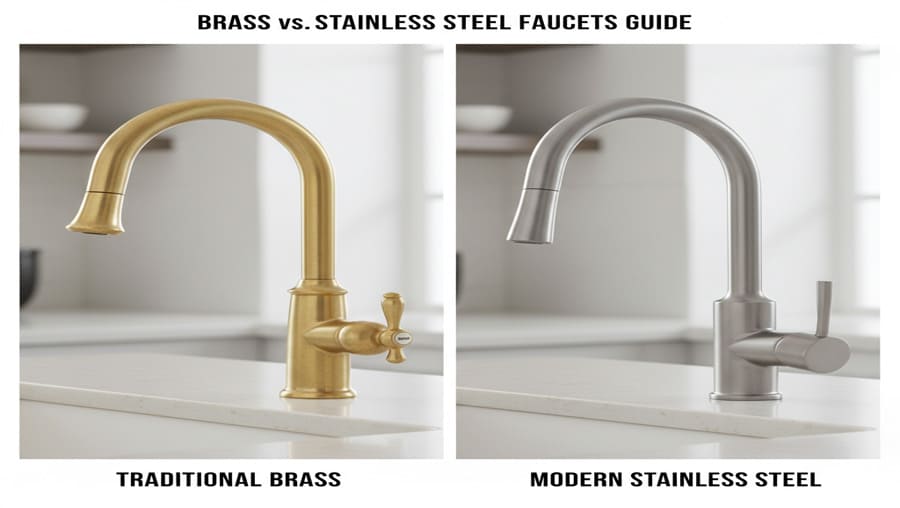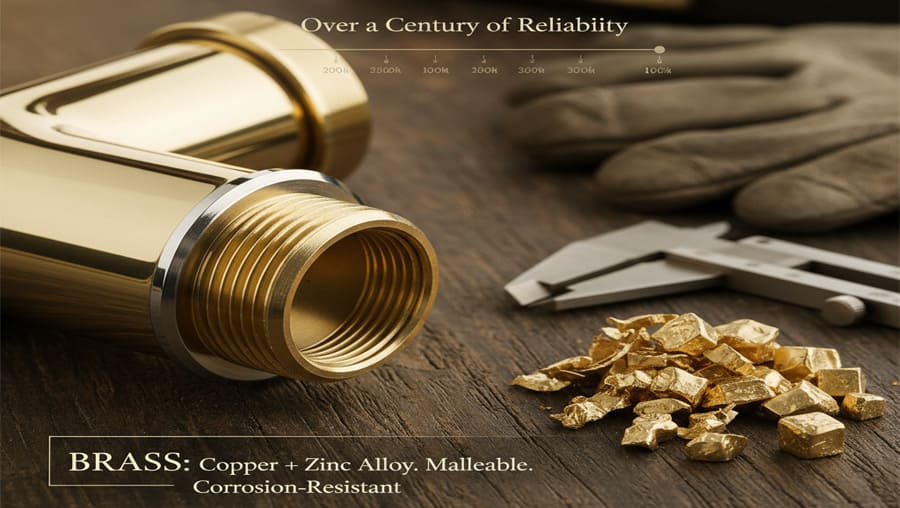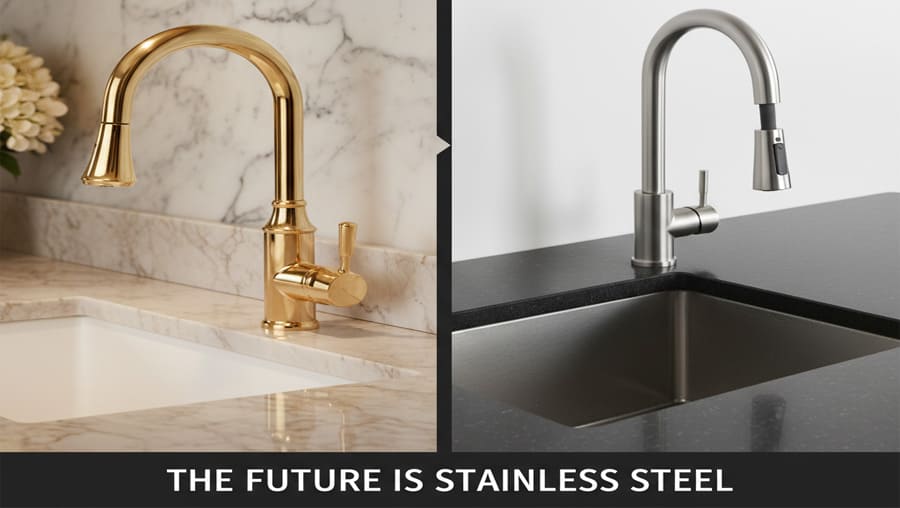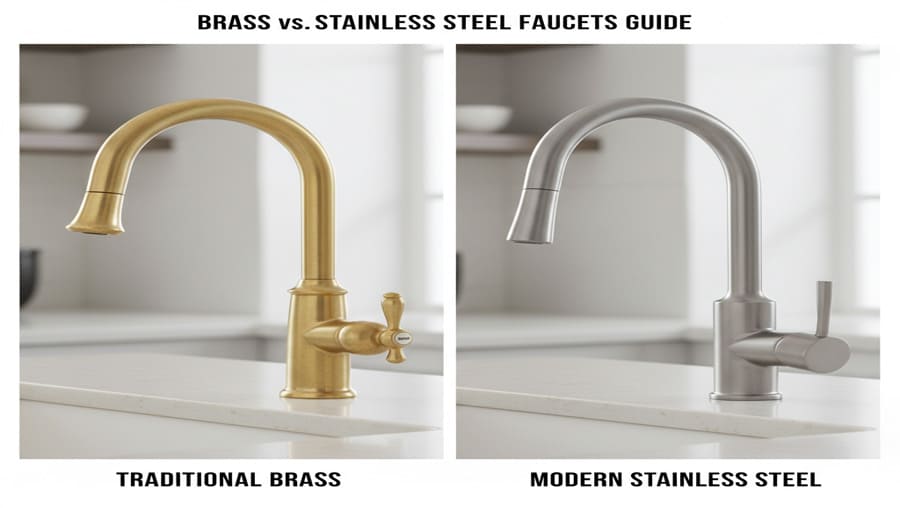For decades, the choice was simple: a faucet was a brass faucet. But as a brand owner, importer, or project manager in today’s market, you know the landscape has dramatically changed. The rise of modern manufacturing and a greater focus on health and cost have brought a powerful challenger to the forefront: stainless steel. The decision between traditional brass and modern stainless steel is no longer just about style; it’s a critical strategic choice that impacts your product’s cost, safety, durability, and market position. This definitive guide will dissect every angle of the brass vs. stainless steel debate, giving you the clarity to choose the right material for your brand’s success.
Last Updated: Nov 2025 | Estimated Reading Time: 15 minutes

The Landscape of Faucet Materials: Beyond a Single Choice
While brass has long been the gold standard, the modern market demands a wider array of options to meet diverse consumer needs and price points. Today’s faucet materials include:
- Brass: The traditional, high-quality standard.
- Stainless Steel: The modern, health-conscious, and durable challenger.
- Zinc Alloy: Often used for handles and baseplates, it’s a lower-cost alternative to solid brass.
- Plastic (ABS): Predominantly used for pull-down spray heads and budget-friendly faucets.
- Aluminum, Zinc-Iron alloys: Niche materials used in specific low-cost applications.
Today, we’re focusing on the two titans of the industry: brass and stainless steel.
What is a Brass Faucet? Understanding the Classic Standard

Brass is an alloy primarily made of copper and zinc. Its excellent malleability, corrosion resistance (when plated), and long history of reliability have made it the go-to material for faucet manufacturing for over a century. However, not all brass is created equal.
The copper content is the key indicator of quality:
- Standard Brass (e.g., 57% Copper): A common, lower-cost brass alloy. It meets basic requirements but may be less durable over the long term.
- High-Quality Brass (e.g., 59% or 62% Copper): This higher copper content improves the alloy’s strength and corrosion resistance, making it a preferred choice for reputable brands.
- Lead-Free Brass: Driven by health regulations like California’s Prop 65 and the US Safe Drinking Water Act, this is a special formulation where lead is replaced with other elements like bismuth. It’s legally defined as having a weighted average lead content of no more than 0.25%.
| Brass Type | Key Characteristic | Best For | What it Means for You |
|---|---|---|---|
| 57% Copper Brass | Cost-effective, standard grade. | Entry-level, price-sensitive markets. | Lower raw material cost but potentially lower perceived quality. |
| 59%+ Copper Brass | Higher durability and corrosion resistance. | Mid-range to high-end brands. | A mark of quality that justifies a higher price point. |
| “Lead-Free” Brass | Complies with strict health regulations. | Markets like North America, Europe, Australia. | Essential for legal compliance and a key selling point. |
What is a Stainless Steel Faucet? The Modern Challenger
Stainless steel is an iron-based alloy containing a minimum of 10.5% chromium. It’s the chromium that gives stainless steel its “stainless” property by forming a passive, self-healing oxide layer that prevents rust. Like brass, stainless steel comes in different grades, and choosing the right one is critical.
- SUS304 Stainless Steel: This is the industry standard for high-quality faucets, also known as 18/8 steel (18% chromium, 8% nickel). It offers an excellent balance of corrosion resistance, durability, and cost. It is naturally lead-free.
- SUS201 Stainless Steel: A lower-cost alternative where manganese replaces much of the nickel. While it looks similar initially, it has significantly lower corrosion resistance and is prone to rusting, especially in humid or coastal areas. It should be avoided for water-bearing components.
- SUS316 Stainless Steel: A premium, “marine-grade” steel with added molybdenum for superior corrosion resistance against chlorides (like salt). While excellent, it is generally considered overkill and too expensive for typical residential faucets.
| Stainless Steel Grade | Key Characteristic | Best For | What it Means for You |
|---|---|---|---|
| SUS201 | Low nickel, low cost. Prone to rust. | Non-water contact decorative parts ONLY. | A major red flag. Using this for a faucet body is a recipe for product failure and brand damage. |
| SUS304 | High nickel, excellent rust resistance, lead-free. | The gold standard for quality faucets. | The best balance of performance, safety, and cost. A powerful marketing message. |
| SUS316 | Marine-grade, ultimate corrosion resistance. | Outdoor, coastal, or laboratory environments. | A premium option for niche applications, but often an unnecessary cost for indoor use. |
Expert Tip: When sourcing, always demand material certification for SUS304. A reputable supplier will have no issue providing a report that verifies the chemical composition. This is your best insurance against unknowingly buying inferior SUS201 products.
Brass vs. SUS304 Stainless Steel: The Ultimate Showdown
Let’s break down the key differences that will impact your business and your customers.
| Feature | Brass Faucet (Lead-Free) | SUS304 Stainless Steel Faucet | The Winner |
|---|---|---|---|
| Health & Safety | Contains trace amounts of lead (Pb) and tin (Sn), though legally compliant (<0.25%). | 100% lead-free. Contains no harmful heavy metals. | Stainless Steel |
| Raw Material Cost | Extremely High & Volatile. Tied to LME copper prices. | Significantly Lower & More Stable. | Stainless Steel |
| Machining & Mfg. Cost | Easier to machine due to softness. Lower tooling costs. | Harder material, requires better tools, higher machining costs. | Brass (in machining) |
| Durability | Relies on a plated finish (e.g., chrome) which can chip or peel. | The material itself is durable and corrosion-resistant. No plating to fail. | Stainless Steel |
| Design Flexibility | Excellent. Softness allows for complex, ornate, and traditional designs. | Good. Best for modern, clean, minimalist designs. Hardness makes intricate shapes difficult. | Brass (for ornate designs) |
| Maintenance | Depends on the finish. Plated finishes can be scratched by abrasives. | Very easy. Brushed finish hides fingerprints. Raw material is very hard to damage. | Stainless Steel |
Deep Dive 1: The Critical Cost Difference
This is the most significant market driver today. The raw material cost of brass is directly tied to the price of copper on the London Metal Exchange (LME).
As you provided, on a given day (e.g., Nov 7th), the LME copper price was $10,918.00 per ton. The price of SUS304 stainless steel raw material at the same time is significantly lower and far more stable.
What this means for you: Sourcing brass faucets means tying your business to a highly volatile commodity market. Unpredictable price spikes can destroy your margins or force you to pass on unpopular price increases to your customers. Stainless steel offers a buffer against this volatility, allowing for more predictable pricing and better long-term financial planning.
Deep Dive 2: Health & Safety – The Unspoken Truth
This is a powerful marketing advantage for stainless steel.
- Brass: Even certified “lead-free” brass contains small, legally permissible amounts of lead. While the risk is low, the conversation around lead in drinking water is a major concern for consumers. The message is complex: “Our faucets meet lead-free standards.”
- Stainless Steel: The message is clean, simple, and absolute: “100% Lead-Free.” The material is inherently free from lead, tin, and other harmful metals. For health-conscious consumers, this is a decisive benefit.
Expert Tip: Use the “100% Lead-Free” message as a cornerstone of your marketing for stainless steel faucets. It’s an easy-to-understand, high-value proposition that resonates strongly with families and health-conscious buyers.
Deep Dive 3: The Paradox of Manufacturing Cost
While stainless steel raw material is cheaper, it’s not always cheaper to produce the final faucet.
- Brass’s Malleability: Brass is a relatively soft metal. It is easy to cast into complex shapes and easy to machine (cut, drill, polish). This means faster production times and less wear and tear on factory tooling.
- Stainless Steel’s Hardness: SUS304 is significantly harder than brass. This is great for durability but presents a challenge for manufacturers. It requires stronger, more expensive cutting tools, slower machining speeds, and more robust equipment. This increases the processing cost compared to brass.
The final unit cost is a balance: Brass has a high raw material cost but lower processing cost. Stainless steel has a low raw material cost but a higher processing cost. In today’s market, the raw material savings from stainless steel almost always outweigh the higher machining costs, resulting in a lower final price.

How to Choose: A Strategic Framework for Your Brand
The right choice depends on your brand identity and target market.
Choose Brass if:
- Your brand identity is built on classic, traditional, or ornate designs. Brass’s malleability is unmatched for creating intricate, detailed shapes that are difficult to achieve with stainless steel.
- You are targeting the luxury market where “solid brass” is perceived as the ultimate standard and customers are less price-sensitive.
- Your desired finish is a very specific color that is only achievable through electroplating on brass.
Choose SUS304 Stainless Steel if:
- Your brand focuses on modern, minimalist, and contemporary aesthetics. The clean lines and brushed finish of stainless steel are a perfect match.
- Health and safety is a key pillar of your brand message. “100% Lead-Free” is your most powerful selling point.
- You are targeting the mid-range to upper-mid-range market where customers value durability, low maintenance, and long-term value.
- You need price stability and want to protect your business from the volatility of the copper market. This is a crucial advantage for long-term planning.
Frequently Asked Questions (FAQ)
Q1: Is brass stronger or more durable than stainless steel? No. Stainless steel is a significantly harder and stronger material than brass. This is why it’s more difficult to machine. A stainless steel faucet is inherently more resistant to scratches and dents. The “durability” of a brass faucet depends almost entirely on the quality and thickness of its protective electroplated coating.
Q2: Why do I see “brass faucet” marketed as a premium feature if it’s less safe? This is due to historical perception. For a century, brass was the only high-quality option, and “solid brass construction” became synonymous with quality. While modern materials like SUS304 are superior in many ways (especially health), this long-standing market perception still exists, particularly in the high-end traditional segment.
Q3: Can a stainless steel faucet ever rust? A high-quality SUS304 or SUS316 stainless steel faucet will not rust in a normal indoor environment. If you see rust on a “stainless steel” faucet, it is almost certainly made from inferior SUS201 grade steel. This is a common cost-cutting tactic by low-quality manufacturers and is a major defect.
Q4: Which material offers better long-term value? For most applications, SUS304 stainless steel offers better long-term value. While the initial purchase price might be similar to a brass faucet today, its superior durability, lack of a plating to fail, and inherent corrosion resistance mean it will look and perform like new for much longer, reducing replacement costs.
Conclusion: The Modern Verdict

While brass will always have a place for its classic beauty and design flexibility, the evidence points to a clear winner for the modern brand. SUS304 stainless steel faucets offer a superior combination of health benefits, durability, and crucial cost stability.
By choosing SUS304 stainless steel, you are arming your brand with a product that is:
- Healthier: Genuinely 100% lead-free.
- Stronger: More resistant to scratches, dents, and corrosion.
- More Stable in Cost: Insulated from the wild swings of the copper market.
- Easier to Maintain: With a finish that won’t chip, flake, or peel.
For the savvy brand builder looking to offer customers long-term value, safety, and modern design, the strategic choice is clear. The future of mainstream, high-quality faucets is forged in stainless steel.
Recommended Links
Internal Links:
- Electroplating vs. PVD: Which Faucet Finish is Right for Your Brand?
- OEM vs. ODM Manufacturing: A Guide for Faucet Brands
- Top 10 Faucet Manufacturers in China (2025 Buyer’s Guide)
External Links (Authoritative Sources):
- Wikipedia: Brass – For a deep dive into the properties and types of brass alloys.
- World Stainless Steel Association: About Stainless Steel – An authoritative source on the science and grades of stainless steel.
- London Metal Exchange (LME): Copper Prices – The official source for tracking the volatile commodity prices that impact brass faucet costs.

